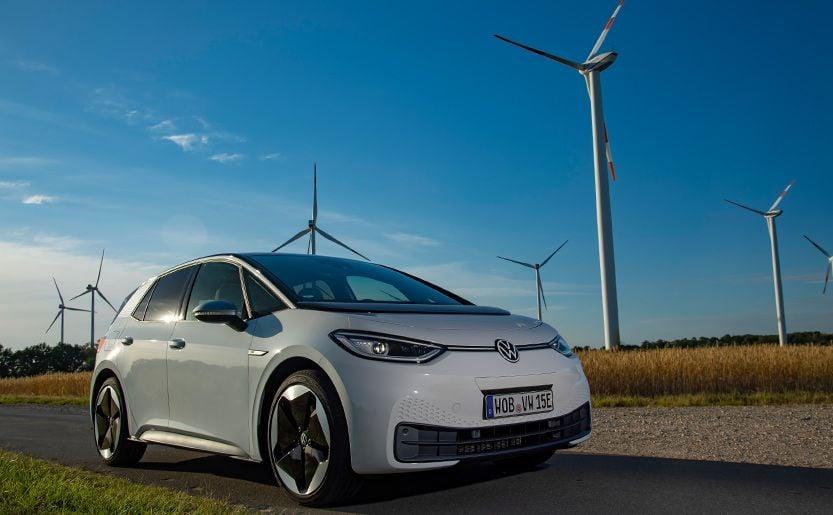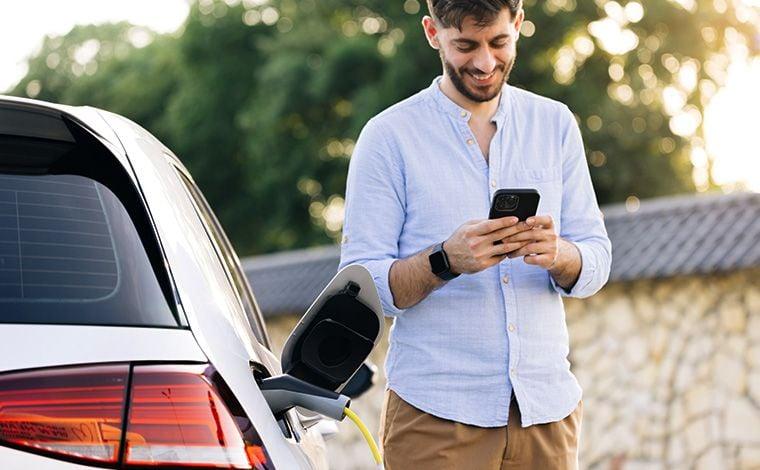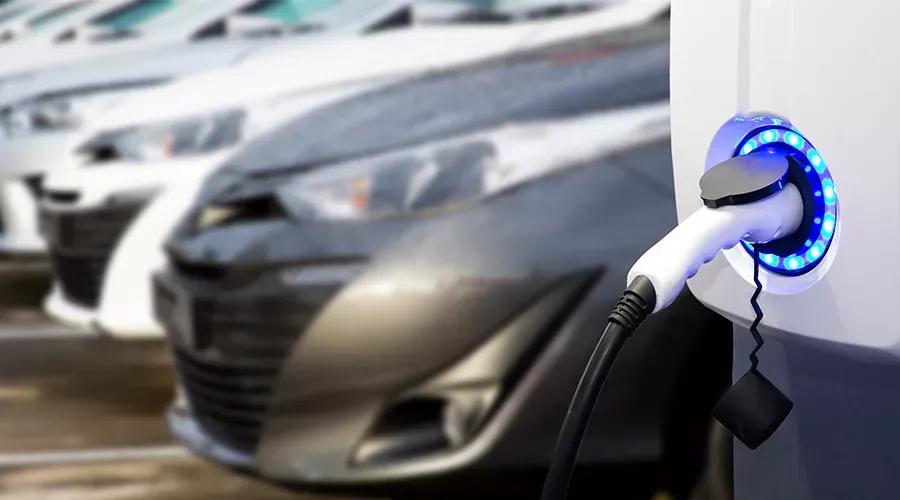The topic of electric car charging is full of mysterious terms and abbreviations. And new terms are being added all the time as technology continues to evolve at a rapid pace.
From AC charging to WLAN - in the following we explain the various technical terms and features of charging stations that are relevant for you when deciding to buy a wallbox and in the electric vehicle environment.
Terms A - C
| AC charging | BMS | Calibrated Energy Meter | Circuit Breaker | CPO |
AC charging
When the electric car is charged with alternating current, it is also referred to as AC charging. Here, the vehicle's on-board AC charger must first convert the alternating current into direct current. Depending on the charger installed, the AC charging power can vary. A VW e-Golf, for example, charges at only 7.2 kW, whereas a Renault ZOE charges at up to 22 kW and is thus ready to drive again much faster. AC charging stations are mostly used at home or at semi-public charging points.
BMS - battery management system
The battery management system is the "brain" of the high-voltage battery. It monitors the states of the cells during operation and charging.
An intelligent battery management system communicates with the wallbox or charging station during charging. This optimizes the charging current for the gentlest possible charging and automatically controls charging. The BMS keeps an eye on the temperature of the cells and prevents deep discharge or overcharging of the battery.
Calibrated Energy Meter
In Germany, all meters – electricity meters in our case – that are used to bill for energy consumption must be calibrated. The Measurement Instruments Directive (MID) is a European Directive on electricity meters. MID-compliant meters do not have to be calibrated before they are put into operation.
Circuit Breaker
A circuit breaker ensures that the current flowing through the circuit does not exceed the levels permitted by the electrical installation. A current that is higher than the permitted level will trigger the circuit breaker (blowing the fuse). You can find out more about why you need a circuit breaker and which is the right choice for you in our installation tips.
CPO
The charging station operator or CPO (Charge Point Operator) is responsible for technical maintenance, power supply and access to its charging infrastructure. Authentication and payment at a charging point is handled by a Mobility Service Provider (MSP), also known as a roaming provider. However, a CPO can also be an MSP at the same time.
Terms D - F
| DC charging | DC residual current protection | Emergency charging cable | Ethernet / LAN |
DC Charging
When charging with direct current, the current is charged directly into the battery. The expensive rectifier is installed in the charging station or charging pole. These so-called fast charging stations enable high charging power. In the case of the Nissan LEAF, for example, up to 50 kW.
DC residual current protection
The DC residual current protection is used for personal protection. A charging station, like a socket outlet, is a point of contact between people and the circuit. This point must be protected by a residual current device (RCD). Our home electrical grid is an alternating current (AC) grid. However, most consumers (e.g. electric vehicle) run on direct current. It can therefore happen that we encounter not only alternating currents in the home network, but also direct currents in isolated cases. Effective personal protection must detect both. This can be done either via a type B RCD or type A-EV RCD or – if the charging station has DC residual current protection – an inexpensive type A RCD is also sufficient. Without DC fault protection in the charging station, a type A RCD would trip too late in the event of a fault.
In short: DC residual currents can be generated by charging the EV. For some RCDs, these fault currents can cause these RCDs to stop functioning properly. DC residual current protection in the charging station prevents this.
Emergency charging cable
The emergency charging cable is the charging cable for the household socket that is usually included with an electric car. The technical term is In-Cable Control and Protection Device (IC-CPD). The IC-CPD monitors the charging process at a household socket. However, the emergency charging cable is not called that for no reason: It is intended for emergencies, i.e. for occasional use when no other charging option is available. This is because domestic Schuko sockets are often not designed for the high continuous load that results when charging an e-car.
Ethernet (also known as LAN, U/ UTP, RJ45)
As an alternative to a SIM card, charging stations can also be connected directly to the Internet for data transfer via a LAN cable. It’s often easier to integrate charging stations with a LAN connection into smart home systems than those with a SIM card, as this means that the charging station is already part of the home network and no additional mobile data costs are incurred. However, you will have to connect the charging station to your Internet router via a LAN cable and you may need to make changes to your firewall.
Terms G - I
| GSM | Intelligent Charging Stations | IP Category |
GSM (also known as mobile data, SIM, GPRS/UMTS/LTE)
The charging station has a mobile modem and can be connected to the Internet via an inserted SIM card. Ideally, you should check whether you have mobile reception in advance. We from The Mobility House only connect SIM cards to roaming tariffs that automatically choose the best mobile network.
Intelligent Charging Stations
Intelligent charging stations are equipped with a communication unit that can control and monitor the charging process (for billing, etc.). This means that, for instance, you can integrate intelligent charging stations into your smart home system, connect them to your photovoltaic plant or use features such as the billing service. The communication interfaces currently used include GSM, Ethernet, WLAN and serial interfaces such as RS485.
IP Category
The IP (Ingress Protection) category indicates the environmental conditions in which the charging station can be used. Most charging stations are suitable for outdoor use. The first number indicates the extent to which the charging station is protected against foreign objects and contact (e.g. with tools), while the second number represents the level of protection against water. The charging stations we offer have the protection category IP 44 or IP 54.
What does IP 44 mean? The charging station is protected against contact with tools and against conductive objects and foreign bodies with a diameter > 1.0 mm. It is also protected against splashing water from any direction.
What does IP 54 mean? The charging station is fully resistant to contact and protected against the build-up of dust in its interior. It is also resistant to splashing water from any direction.
Terms L - M

| Load management | MID | Modbus | Monitoring |
Load Management
Load management means operating several charging stations with a limited connection capacity. If the sum of the loads connected to all the charging stations (e.g. four charging stations, each with 22 kW of charging power = connected load of 88 kW) is greater than the overall connection capacity (e.g. 43 kW), then it must be ensured that the electric cars at the four charging stations do not all use the full 22 kW of power at the same time. Otherwise, the fuse will blow or, at worst, the power cable will overheat.
The most common load management systems have different ways of recognising and
preventing overloading:
1. Load management systems which are familiar to
us detect overloading by directly measuring either the actual power or the
number of electric cars connected.
2. Overloading is prevented in one of
the following ways:
a) The available charging power is reduced for all
charging stations and e.g. all charge with 16 A.
b) The number of
electric cars that can be charged simultaneously is limited, e.g. two electric
cars are charged until their batteries are full.
c) A mixture of these
two strategies is used, e.g. when one electric car must be charged more
quickly than another.
MID
MID (Measurement Instruments Directive) is a European directive for electricity meters. MID-compliant meters do not have to be calibrated before commissioning.
MID electricity meters can be used for kilowatt-hour-accurate billing of electricity – for example, to neighbors who use their own charging station for their electric car - but do not comply with German calibration law for public charging processes.
Modbus
If charging infrastructure is to communicate with the Modbus protocol, which is established as a global industry standard and is used, among other things, in building energy management systems of countless industrial companies or hotels, a translator is needed that has a perfect command of both languages.
A translator mentioned above enables seamless integration of e-cars into existing building energy management systems. Via Modbus TCP, a system capable of this, such as the ChargePilot® charging and energy management system, receives information from how much power is available for all charging points, translates this into OCPP, and in this way dynamically adjusts the energy consumption of the connected electric cars accordingly. The building energy management system reacts flexibly to all other consumers that need to be taken into account in addition to the charging infrastructure.
Monitoring
This refers to the monitoring and evaluation of charging processes at charging stations. Via a web interface that can be accessed from anywhere, CPOs can view all relevant information about your charging infrastructure at any time, e.g. the status of the charging points, the power profile or the currently drawn power. Manage individual charging stations using RFID cards and always keep track of your energy consumption and peak loads.
Terms N - P
| OCPP-Communication | One-Pedal-Driving | PLC | Public charging / semi-public charging | Plug & Charge |
OCPP Communication
OCPP (Open Charge Point Protocol) is an open communication standard published by the Open Charge Alliance. OCPP controls the communication between a charging station and a back-end system, focusing on monitoring and billing. OCPP Version 2.0 also includes charging process control in line with ISO 15118.
The increasing importance of OCPP is also evident from the fact that OCPP controllability of charging infrastructure is becoming a mandatory standard in certain areas, such as the Hamburg and Norderstedt grid area.
One Pedal Driving
With one pedal driving, there is still the "gas" pedal and the brake pedal. However, in some e-cars there is a noticeable deceleration as soon as you lift your foot from the (right) so-called e-pedal. If you use this skillfully, you almost save the brake. It is only used in emergencies when abrupt braking is necessary.
PLC
PLC (power-line communication) can be used to establish digital communication between a charging station and an electric car. It sends data through the charging cable in the form of high-frequency signals. At the moment, this form of communication technology is only being used for the protocols ISO 15118 and DIN 70121. Its aim is to establish a secure, high-performance data connection for authorisation, status queries, charging control and other functions. This technology has limited compatibility with private applications and currently only works with the smart fortwo electric drive. It is mainly used in public DC CCS charging stations. If, for instance, you use one of these stations to charge your electric car, the current charging status and the number of kilowatt hours charged up are displayed on the charging station.
Public charging / semi-public charging
Public charging of electric cars means charging at a freely accessible charging station, such as those provided by the municipal utility or a charging network (NewMotion, Plugsurfing, etc.). Here, drivers can plug in their charging cable at any time and start charging.
Semi-public charging points, on the other hand, are on private property. They are usually only accessible to certain user groups or for a limited period of time (e.g., in supermarket parking lots, in underground parking garages of shopping malls, at the station forecourt, etc.).
Plug & Charge
Plug & Charge (ISO 15118) simplifies charging at public charging stations. Here, the car itself becomes a wallet and fiddling with cards and apps becomes superfluous.
Data exchange between the vehicle and the charging infrastructure is automated and secure. As soon as the charging cable is plugged in, the vehicle communicates with the charging station in encrypted form and the charging process starts automatically. The final payment is also made automatically. Electric car drivers only have to enter their authentication data once in the car.
Terms R - U
| Recuperation | RFID | Residual Current Device | Smart Meter | State of Charge (SoC) |
Recuperation
Recuperation (from Latin recuperare = to recover) is the process of converting the energy released during the braking process of a vehicle with an electric motor back into electrical energy. Especially in city traffic with stop-and-go, recuperation can have a positive effect on electricity consumption. In electric cars, energy recovery technology can reduce electricity consumption by up to 20 percent.
RFID
You can use RFID to protect your charging station against third-party access. Electric car drivers can use an RFID card to identify themselves when connecting to the charging station. The charging process only begins once the user has been verified. The RFID functions offered by different manufacturers vary in the way in which they verify users, how many users can be verified, and whether the user data can be managed via an app or another system. For example, KEBA and Mennekes use what are known as master RFID cards, which the charging station manager can use directly on the premises to approve new RFID card users (RFID with local whitelist). Mennekes also offers the option of managing or deleting users via an app. ICU requires you to log in to an online portal to add a new user by recording the RFID card number.
Residual Current Device (also known as a residual current circuit breaker, RCD, RCCB)
A residual current device, or RCD for short, is used to protect people from electric shocks. A dedicated RCD has been specified for charging electric cars – the RCD type A EV with DC detection, which is a much more affordable solution than the RCD type B otherwise required. You can find out more about why you need an RCD, the different types available and factors to consider when choosing one in our installation tips.
Smart Meter (eHZ, edl21, edl40)
The eHZ (elektronischer Haushaltszähler, electronic domestic supply meter) is not readable/intelligent per se – edl21, edl40
A smart meter is an electricity meter that sends the electricity consumption data to other devices and systems. This makes it possible to bill for the energy used to charge a car automatically, for example. There are two types of smart meter:
1. edl40 smart meters that communicate with the meter operator via a communication module (multi-utility controller)
2. edl21 smart meters that send local data to smart home systems
State of Charge (SoC)
The state of charge of the battery is referred to as the State of Charge. It shows how much energy is still available in the battery and is expressed as a percentage.
Good to know for charging: The fuller the battery, the slower it charges. The 80 percent rule serves as a guide: Up to this value, the electric car charges at a high rate, but after that it only charges slowly. Experts recommend that the state of charge should be between 20 and 80 percent to ensure that the battery lasts as long as possible.
Terms V - Z
| V2G - Vehicle-to-Grid | WLAN |

V2G - Vehicle-to-Grid
"Vehicle to Grid" means that the electric car steps in as temporary battery storage. The vehicle battery returns the stored energy to the power grid at times of increased energy demand.
WLAN (also known as Wi-Fi)
You can integrate a charging station into your home network via WLAN as long as it is not too far away from your router. In this case, too, you may need to make changes to the firewall on your wireless router.



